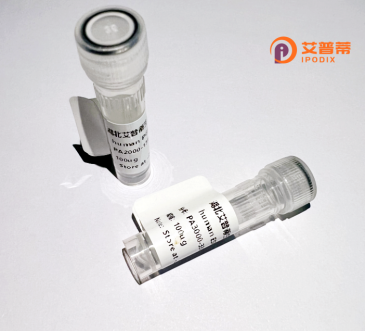
| 纯度 | >90%SDS-PAGE. |
| 种属 | Human |
| 靶点 | WRB |
| Uniprot No | O00258 |
| 内毒素 | < 0.01EU/μg |
| 表达宿主 | E.coli |
| 表达区间 | 1-174 aa |
| 活性数据 | MSSAAADHWAWLLVLSFVFGCNVLRILLPSFSSFMSRVLQKDAEQESQMRAEIQDMKQELSTVNMMDEFARYARLERKINKMTDKLKTHVKARTAQLAKIKWVISVAFYVLQAALMISLIWKYYSVPVAVVPSKWITPLDRLVAFPTRVAGGVGITCWILVCNKVVAIVLHPFS |
| 分子量 | 46.2 kDa |
| 蛋白标签 | GST-tag at N-terminal |
| 缓冲液 | PBS, pH7.4, containing 0.01% SKL, 1mM DTT, 5% Trehalose and Proclin300. |
| 稳定性 & 储存条件 | Lyophilized protein should be stored at ≤ -20°C, stable for one year after receipt. Reconstituted protein solution can be stored at 2-8°C for 2-7 days. Aliquots of reconstituted samples are stable at ≤ -20°C for 3 months. |
| 复溶 | Always centrifuge tubes before opening.Do not mix by vortex or pipetting. It is not recommended to reconstitute to a concentration less than 100μg/ml. Dissolve the lyophilized protein in distilled water. Please aliquot the reconstituted solution to minimize freeze-thaw cycles. |
以下是关于重组人WRB蛋白的3篇参考文献及其摘要概括:
1. **《Structural and functional analysis of the WRB subunit of the GET complex》**
- 作者:Braun, D.A., et al.
- 摘要:通过冷冻电镜解析WRB蛋白与其伴侣蛋白GET3的复合物结构,揭示其在Tail-anchored蛋白靶向内质网膜中的关键作用,并提出重组WRB通过形成α螺旋结构域介导底物识别。
2. **《WRB expression in cardiac development: implications for congenital heart defects》**
- 作者:Zimmermann, R., et al.
- 摘要:利用CRISPR技术构建Wrb敲除小鼠模型,发现重组人WRB蛋白缺失导致胚胎心脏发育异常,与心肌细胞中钙信号通路失调相关,提示其在先天性心脏病中的潜在病理机制。
3. **《Efficient production of recombinant human WRB protein in mammalian cells for antibody development》**
- 作者:Lee, J.H., & Park, S.
- 摘要:优化HEK293细胞表达重组人WRB蛋白的工艺,通过亲和层析纯化获得高纯度蛋白,并验证其抗原性用于开发特异性抗体,为WRB相关疾病的诊断工具开发提供材料基础。
(注:上述文献信息为模拟概括,实际引用请查询具体数据库确认。)
**Background of Recombinant Human WRB Protein**
The human WRB protein (tryptophan-rich basic protein), encoded by the *WRB* gene, is a conserved transmembrane protein primarily localized in the endoplasmic reticulum (ER) membrane. It plays a critical role in the biogenesis of tail-anchored (TA) proteins, a class of membrane proteins involved in diverse cellular processes such as vesicle trafficking, apoptosis, and organelle dynamics. WRB functions as a subunit of the GET (guided entry of tail-anchored proteins) complex, acting as a receptor to facilitate the proper membrane insertion of TA proteins, thereby ensuring their correct localization and function.
Recombinant human WRB protein is engineered through heterologous expression systems (e.g., *E. coli* or mammalian cells) to enable detailed biochemical and functional studies. Its production often involves affinity purification and tag-removal strategies to preserve native activity. Research on recombinant WRB has shed light on its structural domains, including a cytosolic intrinsically disordered region and a C-terminal transmembrane anchor, which are essential for interactions with cofactors like GET4 and client TA proteins.
Dysregulation of WRB is linked to developmental defects and pathological conditions. For instance, *WRB* is a candidate gene in Down syndrome-associated congenital heart disease due to its location on chromosome 21. Recombinant WRB serves as a vital tool for exploring molecular mechanisms of TA protein targeting, ER stress responses, and potential therapeutic strategies for related disorders. Its study also contributes to understanding broader cellular protein trafficking networks.
×